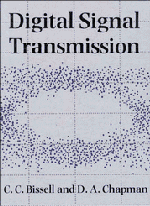Book contents
- Frontmatter
- Contents
- Preface
- 1 Introduction
- PART 1 MODELS
- PART 2 PROCESSES
- PART 3 DIGITAL TRANSMISSION OVER THE PUBLIC SWITCHED TELEPHONE NETWORK
- Appendix A Fourier series and transforms
- Appendix B Convolution
- Appendix C Modelling applications of spreadsheets
- Answers to numerical exercises
- References
- Index
Preface
Published online by Cambridge University Press: 05 June 2012
- Frontmatter
- Contents
- Preface
- 1 Introduction
- PART 1 MODELS
- PART 2 PROCESSES
- PART 3 DIGITAL TRANSMISSION OVER THE PUBLIC SWITCHED TELEPHONE NETWORK
- Appendix A Fourier series and transforms
- Appendix B Convolution
- Appendix C Modelling applications of spreadsheets
- Answers to numerical exercises
- References
- Index
Summary
In this book we try to give a representative (but not comprehensive) treatment of the digital transmission of signals. Our main aim has been to render the material truly accessible to second or third year undergraduate students, practising engineers requiring updating, or graduate physicists or mathematicians beginning work in the digital transmission sector of the telecommunications industry. This has led to a book whose important features are:
A limited number of topics, dealt with in depth
An emphasis on the engineering context and interpretation of mathematical models
Relevance to both students and practising engineers
Engineering is a pragmatic activity, and its models and theory primarily a means to an end. As with other engineering disciplines, much of telecommunications is driven by practicalities: the design of line codes (Chapter 6), or the synchronous digital hierarchy (Chapter 8), for example, owe little to any complicated theoretical analysis of digital telecommunications! Yet even such pragmatic activities take place against a background of constraints which telecommunications engineers sooner or later translate into highly abstract models involving bandwidth, spectra, noise density, probability distributions, error rates, and so on. To present these vitally important ideas – in a limited number of contexts, but in sufficient detail to be properly understood by the reader – is the main aim of this book. Thus timeand frequency-domain modelling tools form one constant theme (whether as part of the theory of pulse shaping and signal detection in Chapter 4, or as a background to the niceties of optical receiver design in Chapter 9); the constant battle against noise and the drive to minimise errors is another.
- Type
- Chapter
- Information
- Digital Signal Transmission , pp. ix - xPublisher: Cambridge University PressPrint publication year: 1992



